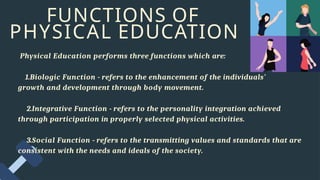Physical-Education-Lesson 1-Fitness.pptx
- 1. PHYSICAL ACTIVITIES TOWARD HEALTH AND FITNESS Prepared: Eric J. Manuevo
- 2. UNIT I. PHY SI CAL EDUCATION
- 3. DEFINITION OF PHYSICAL EDUCATION Physical Education is an integral part of the education program purposely to promote the optimum development of the individual physically, socially, emotionally, and mentally through total movement in the performance of properly selected physical activities (Andin, 2002).
- 4. 1. It provides sensory data. 2. It broadens the perspective horizon. 3. It stimulates function and structure of all bodily organs. 4.It is the means by which an individual learns about himself in relation to his ambient environment. Moreover, Physical Education focuses on the concept of "learn to move, move to learn". An individual must know how to move in order to learn on how to move in order to acquire and learn the needed knowledge in a certain activity. The newer and modern perception of physical education is that it is education through physical activities. In modern physical education idiom, it is education through "movement." Wunderlich (1967) describes of movement as follows:
- 5. LEGAL BASES OF TEACHING PHYSICAL EDUCATION IN THE PHILIPPINES SETTING 1901 Physical exercise was one of the subjects introduced in the public schools and regular program of athletics was developed. 1920 Physical Education was made a required subject subjects in the curriculum of all public schools. 1937 Physical Education was made curricular subject in the secondary school curriculum. 1969 The School of Physical Education and Sports Development Act of 1969. A program of activities included among others: 1. A program of health education and nutrition, 2. A program of physical fitness for all pupils, 3. A program of competitive athletics, 4.A program of intramurals and inter-unit athletic competition within schools, districts, and provinces; and 5. An annual athletic competitions within and among regions.
- 6. 1982 MAPE was introduced and the learning area involves music, arts, and physical education. (Foundation of Physical Education by Carmen Andin) Article XIV Section 19 (1) & (2) of the 1987 Philippine Constitution mandates that: (Bold) The state shall promote physical education and encourage sports programs, league competitions, and amateur sports, including training for international competitions, to foster self-discipline, teamwork, and excellence for the development of a healthy and alert citizenry. All educational institutions shall undertake regular sports activities throughout the country in cooperation with athletic clubs and other sectors. (Italic)
- 7. FUNCTIONS OF PHYSICAL EDUCATION Physical Education performs three functions which are: 1.Biologic Function - refers to the enhancement of the individuals' growth and development through body movement. 2.Integrative Function - refers to the personality integration achieved through participation in properly selected physical activities. 3.Social Function - refers to the transmitting values and standards that are consistent with the needs and ideals of the society.
- 8. A MAJOR GOAL OF PHYSICAL EDUCATION Physical education as a component of the educational system strives to aid or facilitate the development of an individual so that he can achieve total fitness to allow him to envoy's the "good life." Therefore, a major goal of physical education is FITNESS.
- 9. Through cautiously selected physical education activities, an individual who participates energetically will develop and maintain good health and a high level of physical fitness. The attainment of physical skills can motivate an individual who participates further in physical activities; hence, his growth and development will be improved. OBJECTIVES OF PHYSICAL EDUCATION Physical Development
- 10. Social Development Involvement in Physical Education activities provides opportunities for the development of enviable social traits needed for adjustment to the social life in general. Some worthwhile traits are: 1. friendliness 2. cooperation 3. respect for the rights of others 4. good sportsmanship 5. good leadership and followership 6. honesty in group competition
- 11. Emotional Development The informal nature of physical education activities offers opportunities for self-expression and emotional mastery. Examples of worthwhile emotional traits are: 1. self-confidence 2. self-control 3. self-reliance 4. courage 5. determination
- 12. Mental Development Through participation in physical education activities, the individual develops his mental capacities as he learns the mechanical principles of underlying movements, as he obtains knowledge and understanding of the rules and strategies of the games and sports, and as he discovers ways of improving his movement in gymnastics and dance. Likewise, it enhances critical thinking how activities are done according to rules, regulations and strategies
- 13. OBJECTIVES OF PHYSICAL EDUCATION 1.Knowledge - it enhances critical thinking how activities are done according to rules, regulations and strategies. 2.Physical fitness - improves and maintains the workload of the individual without staggering and undue fatigue after which have time or energy to meet some more emergencies in life. 3.Social - to understand oneself; to get along with others for effective living.
- 14. 4.Motor skills - it is the learning of the fundamental skills necessary for participation in sports and games. 5.Aesthetic - relating or responsive to or appreciative of what is pleasurable to the senses. 6.Nationalism - preservation of cultural heritage through revival of indigenous games, dances and sports. 7.Conservation of natural environment such as protection of forest and aquatic resources.
- 15. THANK YOU FOR LISTENING! Don't hesitate to ask any questions!














